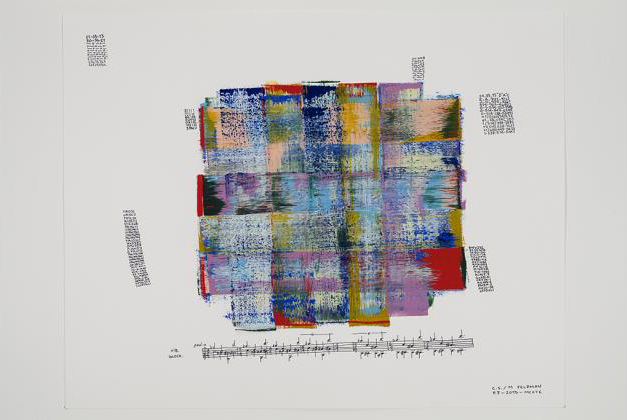Music has always been a mystery to me. Its not like I haven’t tried, a year of music class and clarinet got me right back at square one: no musical capacity whatsoever. So when we start talking experimental music and improvisation, I am quite out of my comfort zone. However, the work by Mario Côte at the Galerie Trois Point is most interesting and caught my full attention. Mario Côté is a professor at l’Université du Québec à Montréal and the exhibition Table d’écoute is curated by his colleague Patrice Loubier Art History Professor also at UQAM.
The exhibition focuses on Côté’s work with music, more specifically Morton Feldman composition Crippled Symmetry (1983). The large canvases we see upon entering the exhibition each represent a measure of Crippled Symmetry, itself composed of 1252 measures (approximating a total of 40 canvases). The artworks are abstract dominated by geometric forms; in this sense they are indeed representative of Feldman’s music. To be able to relate to these paintings I have sat through a youtube version of Crippled Symmetry. Although listening to the hour long composition did not rock my boat it certainly shed a light on Côte’s work (and annoyed my cat!). The repetition and the slow pace for example can be recognized in the visual interpretation of the pieces created by the artist, even for the musical illiterate that I am.
Through an idea that came from “number painting” and his interest music, Côté has developed a chart to transcribe music onto canvas (these charts are also in the show). Number painting is a popular amateur painting process where the canvas is already divided into numbered zones that will form the final image and a palette of numbered colors corresponding to the numbered zones. The creative process has already been done, the amateur painter only needs to fill in the color in the corresponding spot. Côté has experimented with these number paintings by changing the color codes resulting in the abstraction of the pre-determined image. The abstraction goes further when the canvas in turned over to the side, this can be observed in Planche d’abstraction no.1 and Planche d’abstraction no.4 (2013).
I would argue that the art piece is not only the final canvas, but the creation process as a whole. The exhibition layout seems to incarnate this idea as drafts, charts, research and influences are also present thus contextualizing the Crippled Symmetry (CS)Â pieces. In addition a reading of Crippled Symmetry will take place on November 9th to complete the artwork. As mentioned before, influences are also exhibited such as the piece Etat d’un tableau (2000-2001) or the Mur d’atelier series that show a deep connection to Abstract Expressionism (1940s) which influenced the New York School (end 1960s) and itself including avant-guard musicians like John Cage (to name the most famous one) as well as Morton Feldman. What interested these musicians was primarily the tendency towards the unpredictable, improvisation and the movement required from the body during the creation process.
When visiting Table d’écoute we are made aware that every aspect of the art from inspiration to the canvas is actually part of the final piece. Don’t miss the performance on November 9th (3pm at the gallery) to experience the art piece in its whole!
Galerie Trois Point
Mario Côté
Tables d’écoute
October 12 – November 16, 2013
http://galerietroispoints.com



